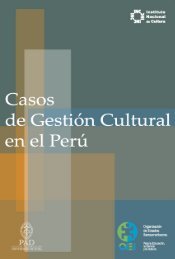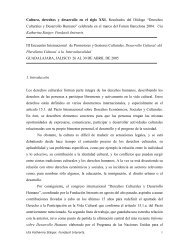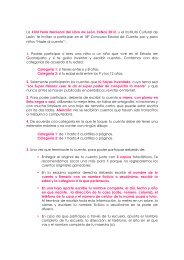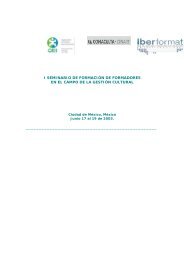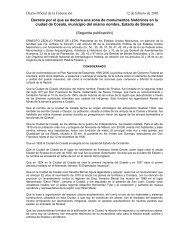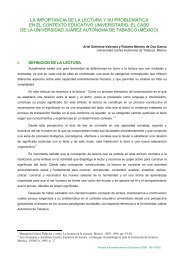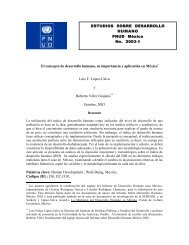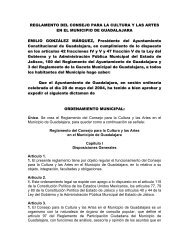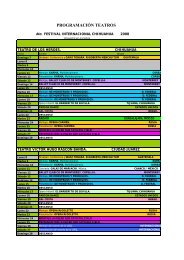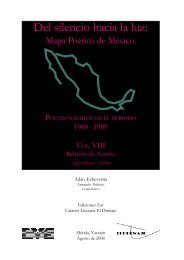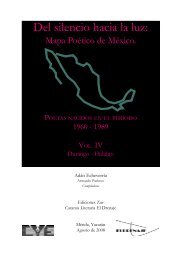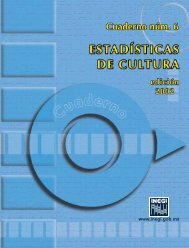Guía para la elaboración de mapeos regionales de industrias creativas
GUIA MRIC_Feb26 06.indd - Sistema de Información Cultural
GUIA MRIC_Feb26 06.indd - Sistema de Información Cultural
- No tags were found...
Create successful ePaper yourself
Turn your PDF publications into a flip-book with our unique Google optimized e-Paper software.
3. COBERTURALa cobertura geográfica <strong>de</strong>l estudio es nacional(Japón).Con base en <strong>la</strong> sectorización <strong>de</strong> <strong>industrias</strong> <strong>creativas</strong><strong>de</strong>l Reino Unido, el estudio agrupó <strong>la</strong>s <strong>industrias</strong><strong>creativas</strong> en doce categorías:••••••••••••Arquitectura y servicios <strong>de</strong> ingenieríaCine y vi<strong>de</strong>oDiseñoEditorialesMercado <strong>de</strong> antigüeda<strong>de</strong>sManufacturas <strong>la</strong>cadas (<strong>la</strong>cquer ware 7 )Música, artes escénicasOrganizaciones artísticas, académicas yculturalesProducción, venta y alquiler <strong>de</strong> grabacionesen audio y vi<strong>de</strong>oPublicidadRadio y televisiónSoftware <strong>de</strong> computadormas actuales <strong>de</strong> <strong>la</strong> industria <strong>de</strong>l contenido, <strong>de</strong>METI (2003)• Para entretenimiento, danzas y teatro, se usaronlos resultados <strong>de</strong> Encuesta sobre el Estado<strong>de</strong>l Intercambio Cultural Internacional, <strong>de</strong>lInstituto <strong>de</strong> Investigación NLI4.3 TIPO DE INFORMACIÓNLa información usada fue cuantitativa.5. FORTALEZAS Y DEBILIDADESLa principal fortaleza <strong>de</strong>l estudio radica en haberempleado <strong>la</strong> metodología estándar <strong>de</strong>l ReinoUnido <strong>para</strong> cuantificar <strong>la</strong> contribución <strong>de</strong> <strong>la</strong>s <strong>industrias</strong><strong>creativas</strong>, lo que permite com<strong>para</strong>cionesinternacionales.4. ASPECTOS METODOLÓGICOS4.1 TEMAS, VARIABLES, INDICADORESHubo tres temas básicos analizados <strong>para</strong> <strong>la</strong>s <strong>industrias</strong><strong>creativas</strong> en el estudio japonés:•••Estado <strong>de</strong> <strong>la</strong>s <strong>industrias</strong> <strong>creativas</strong>, medido a través<strong>de</strong>l número <strong>de</strong> establecimientos y <strong>de</strong>l número<strong>de</strong> personas vincu<strong>la</strong>das a estas activida<strong>de</strong>s.IngresosComercio, que compren<strong>de</strong> importaciones yexportaciones.4.2 FUENTES DE INFORMACIÓNEl estudio empleó información secundaria proveniente<strong>de</strong> <strong>la</strong>s siguientes fuentes:• Ministerio <strong>de</strong> Gestión Pública, Asuntos Locales,Correos y Telecomunicaciones: Censo <strong>de</strong>Empresas y Establecimientos 2001; Encuesta<strong>de</strong> Industrias <strong>de</strong> Servicios 1999.• Para editorial, música, difusión, cine y software<strong>de</strong> juegos, se usó el estudio Estado y te-7 Artesanía tradicional <strong>de</strong> Japón.112GUÍA PARA LA ELABORACIÓN DE MAPEOS REGIONALES DE INDUSTRIAS CREATIVAS



